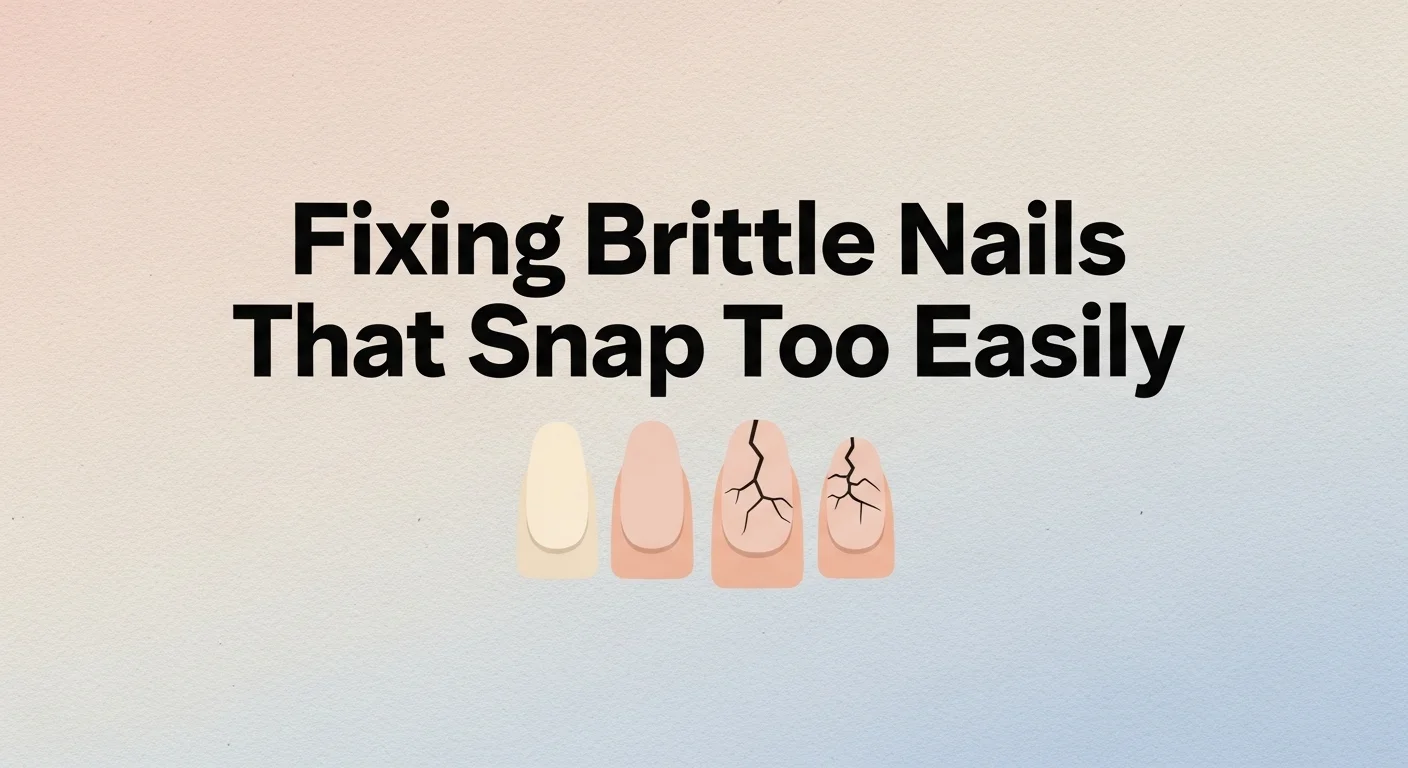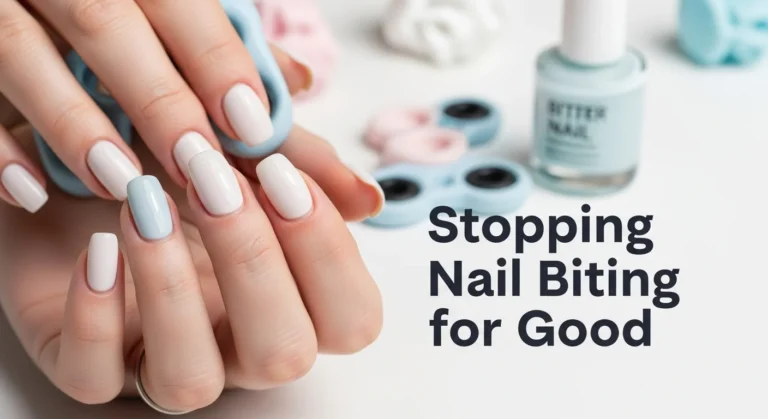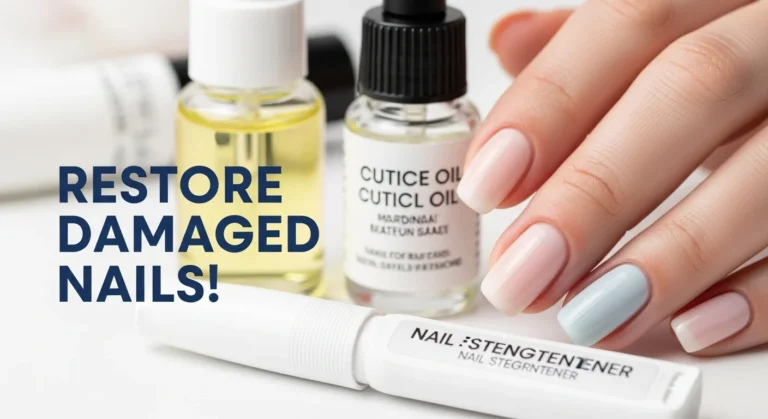Fixing Brittle Nails That Snap Too Easily
Brittle nails that break or split easily can result from dehydration, frequent exposure to harsh chemicals, nutritional deficiencies, or underlying health conditions. Improving nail strength involves hydration, protective habits, balanced nutrition, and, in some cases, medical consultation.
What Causes Brittle Nails?
Brittle nails (onychorrhexis) can be dry, weak, or prone to splitting. Common causes include:
- Frequent Wetting/Drying: Repeated hand washing, dishwashing, or swimming can strip natural oils.
- Chemical Exposure: Nail polish removers, cleaning products, and harsh soaps can weaken nails.
- Nutritional Gaps: Low levels of iron, biotin, or protein may affect nail health.
- Aging: Nails naturally lose moisture and elasticity with age.
- Medical Conditions: Thyroid disorders, anemia, or skin conditions (psoriasis, eczema) can contribute.

How to Strengthen Brittle Nails
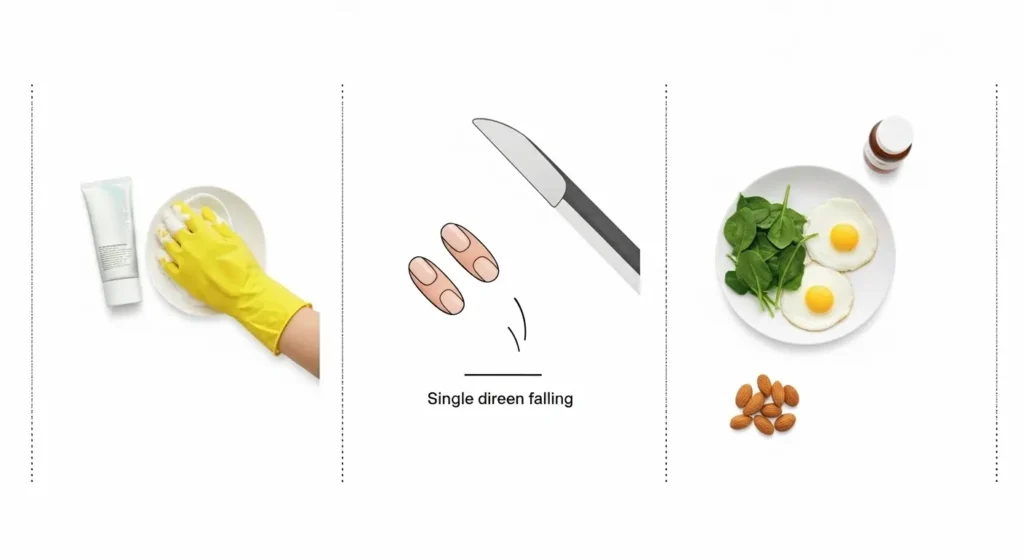
1. Moisturize and Protect
- Apply fragrance-free hand cream or cuticle oil regularly.
- Wear gloves when cleaning or washing dishes.
- Avoid prolonged exposure to hot water.
2. Nail Care Practices
- Keep nails trimmed to reduce stress on edges.
- File in one direction instead of sawing back and forth.
- Avoid acrylics, gels, or harsh nail products if nails are already fragile.
- Limit nail polish remover use (especially acetone-based).
3. Nutrition and Lifestyle
- Ensure adequate protein intake (keratin is protein-based).
- Iron, zinc, and biotin deficiencies may affect nail strength.
- Stay hydrated to reduce dryness.
- Avoid smoking, which reduces blood flow and nutrient delivery to nails.
Fixing (restore) Brittle Nails Naturally
Many people prefer to start with natural remedies and lifestyle changes before turning to supplements or medical treatments. While results vary, these methods often focus on hydration, protection, and balanced nutrition.
1. Natural Moisturizers
- Coconut oil: Helps lock in moisture and reduce dryness.
- Olive oil: Contains vitamin E and fatty acids that may support nail flexibility.
- Shea butter or petroleum jelly: Seals moisture when applied after handwashing.
Tip: Apply oils or creams at night and wear cotton gloves to enhance absorption.
2. Dietary Support
- Protein-rich foods: Eggs, beans, fish, and lean meat help produce keratin.
- Iron sources: Leafy greens, red meat, or fortified cereals may reduce nail thinning linked to anemia.
- Biotin-rich foods: Nuts, seeds, and whole grains provide nutrients sometimes linked to stronger nails.
- Hydration: Drinking water consistently helps prevent nail dryness.
3. Protective Habits
- Limit harsh chemicals: Use gentle soaps and avoid acetone-based nail removers.
- Gloves: Wear them while gardening, cleaning, or washing dishes.
- Nail hygiene: Keep nails trimmed and filed to prevent splitting.
4. At-Home Soaks (Traditional Approaches)
Some people try mild soaks to hydrate and strengthen nails:
- Warm olive oil soak (5–10 minutes, 2–3 times weekly).
- Diluted apple cider vinegar soak (may help balance pH and reduce brittleness).
- Epsom salt soak (for overall nail and skin relaxation).
(Note: Scientific evidence is limited for these soaks, but they are generally safe if used moderately.)
✅ Natural care works best when combined with consistent protective habits and a balanced diet. Results are gradual, usually noticeable after several months of consistent care.
Brittle Nails Meaning
Brittle nails are fingernails or toenails that break, split, peel, or crack more easily than normal. In medical terms, this condition is often called onychoschizia (splitting or layering) or onychorrhexi (longitudinal ridging and breakage).
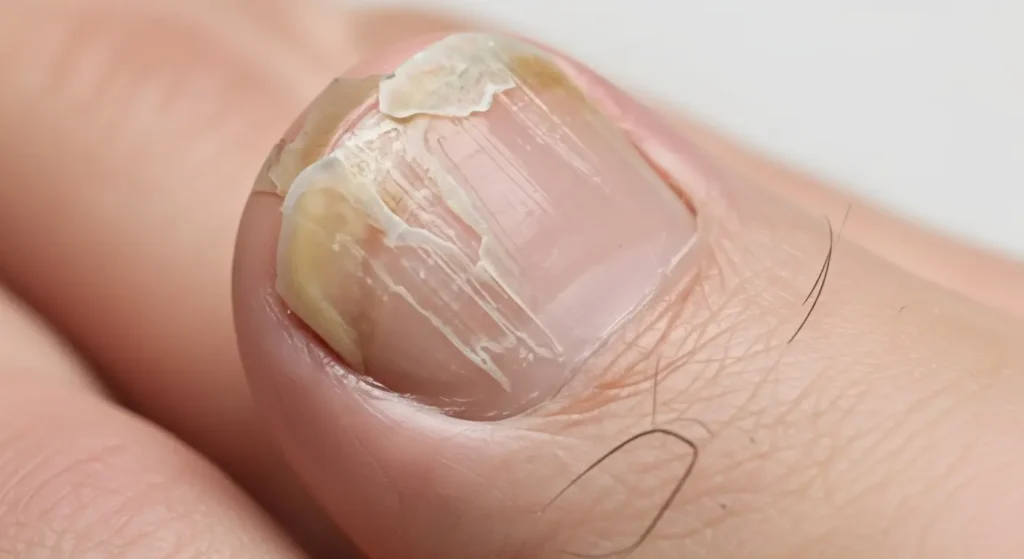
What It Looks Like:
- Nails that split at the edges.
- Thin layers peeling away.
- Rough or uneven surfaces.
- Cracking when nails are bent slightly.
Why It Matters:
Brittle nails are usually harmless and linked to dryness, aging, or everyday habits (like frequent washing or chemical exposure). However, in some cases, they can signal nutritional deficiencies or underlying health issues such as anemia or thyroid disorders.
Quick Facts:
- About 20% of people experience brittle nails at some point.
- More common in women and older adults.
- Often worsens in cold, dry weather or with repeated wetting and drying.
At-Home Remedies People Commonly Try
(Note: effectiveness varies and evidence is mixed)
- Petroleum jelly or natural oils (coconut, almond) for sealing in moisture.
- Soaking nails in warm water and applying moisturizer immediately after.
- Avoiding frequent nail polish to give nails time to recover.
When to Seek Medical Advice
If brittle nails do not improve with lifestyle adjustments, consider medical evaluation. Warning signs include:
- Nails that split vertically into the nail bed.
- Pain, swelling, or redness around nails.
- Sudden onset of brittleness without clear cause.
- Accompanied by hair loss, fatigue, or unexplained weight changes.
Data Table: Nail Weakness: Possible Causes and Solutions
| Cause | Typical Signs | Possible Solutions |
|---|---|---|
| Frequent wetting/drying | Peeling, splitting at tips | Gloves, moisturizers |
| Chemical exposure | Discoloration, rough surface | Limit removers, use gentler soaps |
| Nutritional deficiencies | Slow growth, thin nails | Balanced diet, check for low iron/biotin |
| Aging | Ridges, dryness, slow growth | Hydration, gentle nail care |
| Medical conditions | Severe splitting, systemic issues | Doctor evaluation, treatment of cause |
Fixing Dry Brittle Nails
Why it happens:
- Repeated handwashing or sanitizer use.
- Cold, dry weather stripping natural oils.
- Overuse of nail polish remover or harsh soaps.
- Dehydration (not enough water intake).
What helps:
- Moisturize regularly with hand cream, cuticle oil, or petroleum jelly.
- Apply oils (coconut, almond, or olive oil) at night to lock in hydration.
- Limit hot water exposure — use lukewarm instead.
- Wear gloves when washing dishes or cleaning.
- Stay hydrated throughout the day.
Extra Tip: A humidifier in dry climates can help restore moisture to nails and skin.
Fixing Thin Brittle Nails
Why it happens:
- Nutritional gaps (iron, zinc, protein).
- Frequent filing or over-buffing.
- Long-term use of acrylics, gels, or harsh chemicals.
- Genetics — some people naturally have thinner nails.
- Underlying health conditions (thyroid issues, anemia).
What helps:
- Strengthen through diet → protein-rich foods, leafy greens, nuts, and seeds.
- Avoid aggressive nail products like acrylic extensions or acetone removers.
- Use protective coatings (gentle strengthening base coats, non-acetone polish).
- Keep nails short to reduce bending and splitting.
- Seek medical advice if nails remain thin despite lifestyle changes.
Extra Tip: Because nails grow slowly (about 3 mm/month), improvements in thickness may take 3–6 months of consistent care.
Brittle Nails and Vitamin Deficiency
Nails that break, split, or peel can sometimes be linked to a lack of certain nutrients. While brittle nails are often caused by everyday habits or aging, deficiencies may also play a role.

Key Nutrients Linked to Nail Health
- Iron → Low iron (anemia) is one of the most common causes of thin, weak nails.
- Biotin (Vitamin B7) → Supports keratin production; deficiency may lead to brittle, slow-growing nails.
- Zinc → Low levels can affect nail growth and repair.
- Protein → Nails are made of keratin (a protein); not eating enough can weaken nails.
- Other B vitamins (B12, folate) → Help with red blood cell production, which supports nail health.
Signs That Point to Possible Deficiency
- Nails that split easily despite good care.
- Unusual changes like spoon-shaped nails (linked to iron deficiency).
- Slow nail growth.
- Other symptoms such as fatigue, hair thinning, or pale skin (may suggest anemia).
What Helps
- Eat a balanced diet with lean meats, eggs, beans, leafy greens, nuts, and whole grains.
- If you suspect a deficiency, ask a healthcare professional about blood tests before starting supplements.
- Improvements take time — nails may need 3–6 months to show visible changes.
Vitamin Deficiency → Nail Sign → Food Sources
| Vitamin / Nutrient | Possible Nail Sign | Food Sources |
|---|
| Iron | Thin, spoon-shaped, or brittle nails | Red meat, spinach, lentils, fortified cereals |
| Biotin (B7) | Brittle, splitting, slow growth | Eggs, nuts, seeds, whole grains |
| Vitamin B12 | Dark streaks, ridges, slow growth | Fish, poultry, dairy, fortified plant milks |
| Folate (B9) | Ridged or weak nails | Leafy greens, beans, citrus fruits |
| Zinc | White spots, weak nail growth | Pumpkin seeds, chickpeas, seafood |
| Protein | General thinning, soft nails | Eggs, chicken, |
Folate Deficiency Nails: What They Reveal About Your Health
- Folate deficiency nails may appear brittle, ridged, or pale.
- Vitamin B12 deficiency can cause dark streaks, ridges, or bluish discoloration in nails.
- Vitamin D deficiency often shows as brittle, peeling, or slow-growing nails.
- Both folate and B12 deficiencies are linked to anemia and sometimes may signal underlying health issues, including cancer.
Signs of Folate Deficiency in Nails
When the body lacks folate (vitamin B9), it affects red blood cell production and oxygen delivery, which can show up in the nails:
- Pale or bluish nail beds
- Brittle nails that break easily
- Vertical ridges (lines running from cuticle to tip)
- Slow nail growth
👉 In women, low folic acid symptoms may also include fatigue, mouth sores, irritability, and hair thinning along with nail changes.
Signs of Vitamin Deficiency in Nails
Nails can often give early warning signs of nutrient deficiencies:
| Vitamin Deficiency | Nail Signs | Other Common Symptoms |
|---|---|---|
| Folate (B9) | Pale, brittle, ridged nails | Fatigue, anemia, mouth sores |
| Vitamin B12 | Dark streaks, ridges, spoon-shaped nails | Tingling, memory issues, weakness |
| Vitamin D | Brittle, peeling, slow-growing nails | Bone pain, frequent illness, fatigue |
| Iron | Spoon-shaped nails, pale nail beds | Fatigue, dizziness, weakness |
| Biotin (B7) | Soft, thin nails that split easily | Hair loss, skin rashes |
Vitamin B12 Deficiency Fingernails (With Examples)
People with B12 deficiency may notice:
- Dark vertical lines or streaks on the nails
- Blue or purplish nail beds due to poor circulation
- Spoon-shaped or unusually thin nails
- Increased brittleness
(Pictures are often used in medical references, but nail changes alone should not be used for diagnosis—lab tests are necessary.)
Can Low Folate Be a Sign of Cancer?
Low folate levels do not automatically mean cancer, but chronic deficiency has been linked to higher risks of certain cancers, especially:
- Colorectal cancer
- Cervical cancer
- Stomach cancer
Why? Folate plays a role in DNA repair. Deficiency may make cells more vulnerable to mutations.
What Type of Cancer Causes Folic Acid Deficiency?
In some cases, cancers affecting the digestive system may cause folate deficiency by reducing absorption:
- Colorectal cancer
- Gastric (stomach) cancer
- Pancreatic cancer
Cancer treatment (chemotherapy, methotrexate) can also interfere with folate metabolism.
Low Folic Acid Symptoms in Females
Women may notice these signs most often:
- Weak, brittle nails
- Fatigue and weakness
- Mouth ulcers or tongue soreness
- Hair thinning
- Difficulty concentrating
- Irregular periods in severe cases
Vitamin D Deficiency Nails
Nails may appear:
- Thin and brittle
- Slow-growing
- Peeling in layers
- Prone to breakage
Since vitamin D supports calcium absorption, deficiency often affects bone and nail health together.
Best Supplements for Nail Growth
While nail health depends on a balanced diet, these nutrients are most often recommended:
- Biotin (Vitamin B7) – strengthens brittle nails.
- Folate (Vitamin B9) – supports cell growth and nail development.
- Vitamin B12 – maintains nail color and structure.
- Vitamin D + Calcium – for stronger nails and bones.
- Iron & Zinc – prevent spoon-shaped, weak nails.
Tip: A general multivitamin or B-complex may be more effective than a single supplement if multiple deficiencies are possible.

